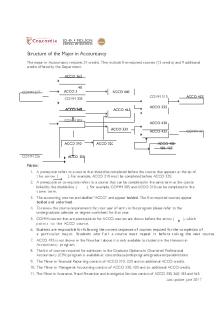Formulas Flowchart - Lecture notes 1 PDF

| Title | Formulas Flowchart - Lecture notes 1 |
|---|---|
| Author | Emma Jane |
| Course | Intro To Chemical Research |
| Institution | Kent State University |
| Pages | 1 |
| File Size | 108.4 KB |
| File Type | |
| Total Downloads | 101 |
| Total Views | 124 |
Summary
Dr. F...
Description
Nomenclature: Writing Formulas Flowchart Refer to the "Reference Sheet for Chemical Nomenclature" for tables of ions and prefixes.
Ionic or Molecular? decision
decision
Ionic
Molecular
Contains metal or “ammonium” (NH4+) in name
Contains all non-metal atoms (except ammonium compounds like NH4Cl) question
ACTION
Acid (HnX) or Not ? acids contain “acid” in name decision
Write Cation 1st Main group Metal – predict charge using Periodic Table Transition Metal – the Roman numeral gives the charge Ammonium – NH4+1 Write Anion 2nd monatomic – has “-ide” ending (except hydroxide, cyanide). Predict charge using Periodic Table polyatomic – has “-ite” or “-ate” ending or is hydroxide or cyanide. You just have to know these – name, formula and charge! Determine Proper Subscripts for each ion: do “switcheroo” – make each charge the subscript on the opposite ion! Place parentheses around any polyatomic ion if subscript > 1 reduce subscripts to lowest forms if needed Ex: “chromium(IV) sulfate” 1. Cr4+ SO422. Cr2 (SO4)4 – subscripts reducible! 3. Final: Cr(SO4)2
Acid Has H followed by some ion formula
decision
Not Acid
ACTION
ACTION
KNOW THESE: HCl = hydrochloric acid HNO3 = nitric acid H2SO4 = sulfuric acid HC2H3O2 = acetic acid be ready to learn new as needed
Place Least Electronegative element first usually 1st in name (many exceptions here) “farthest from King Fluorine” numerical prefix gives the subscript Place other element second numerical prefix gives subscript DO NOT REDUCE subscripts for molecular compounds – these are molecular formulas and give actual atom counts (not just ratios like ionic) Ex: “dinitrogen trioxide” = N2O3 “tertraphosphorous hexoxide” = P4O6...
Similar Free PDFs

Formulas - Lecture notes 1
- 40 Pages

Flowchart - Lecture notes 1-10
- 18 Pages

Flowchart-acco - flowchart
- 1 Pages

Risk Stratification Flowchart 1
- 4 Pages
Popular Institutions
- Tinajero National High School - Annex
- Politeknik Caltex Riau
- Yokohama City University
- SGT University
- University of Al-Qadisiyah
- Divine Word College of Vigan
- Techniek College Rotterdam
- Universidade de Santiago
- Universiti Teknologi MARA Cawangan Johor Kampus Pasir Gudang
- Poltekkes Kemenkes Yogyakarta
- Baguio City National High School
- Colegio san marcos
- preparatoria uno
- Centro de Bachillerato Tecnológico Industrial y de Servicios No. 107
- Dalian Maritime University
- Quang Trung Secondary School
- Colegio Tecnológico en Informática
- Corporación Regional de Educación Superior
- Grupo CEDVA
- Dar Al Uloom University
- Centro de Estudios Preuniversitarios de la Universidad Nacional de Ingeniería
- 上智大学
- Aakash International School, Nuna Majara
- San Felipe Neri Catholic School
- Kang Chiao International School - New Taipei City
- Misamis Occidental National High School
- Institución Educativa Escuela Normal Juan Ladrilleros
- Kolehiyo ng Pantukan
- Batanes State College
- Instituto Continental
- Sekolah Menengah Kejuruan Kesehatan Kaltara (Tarakan)
- Colegio de La Inmaculada Concepcion - Cebu











